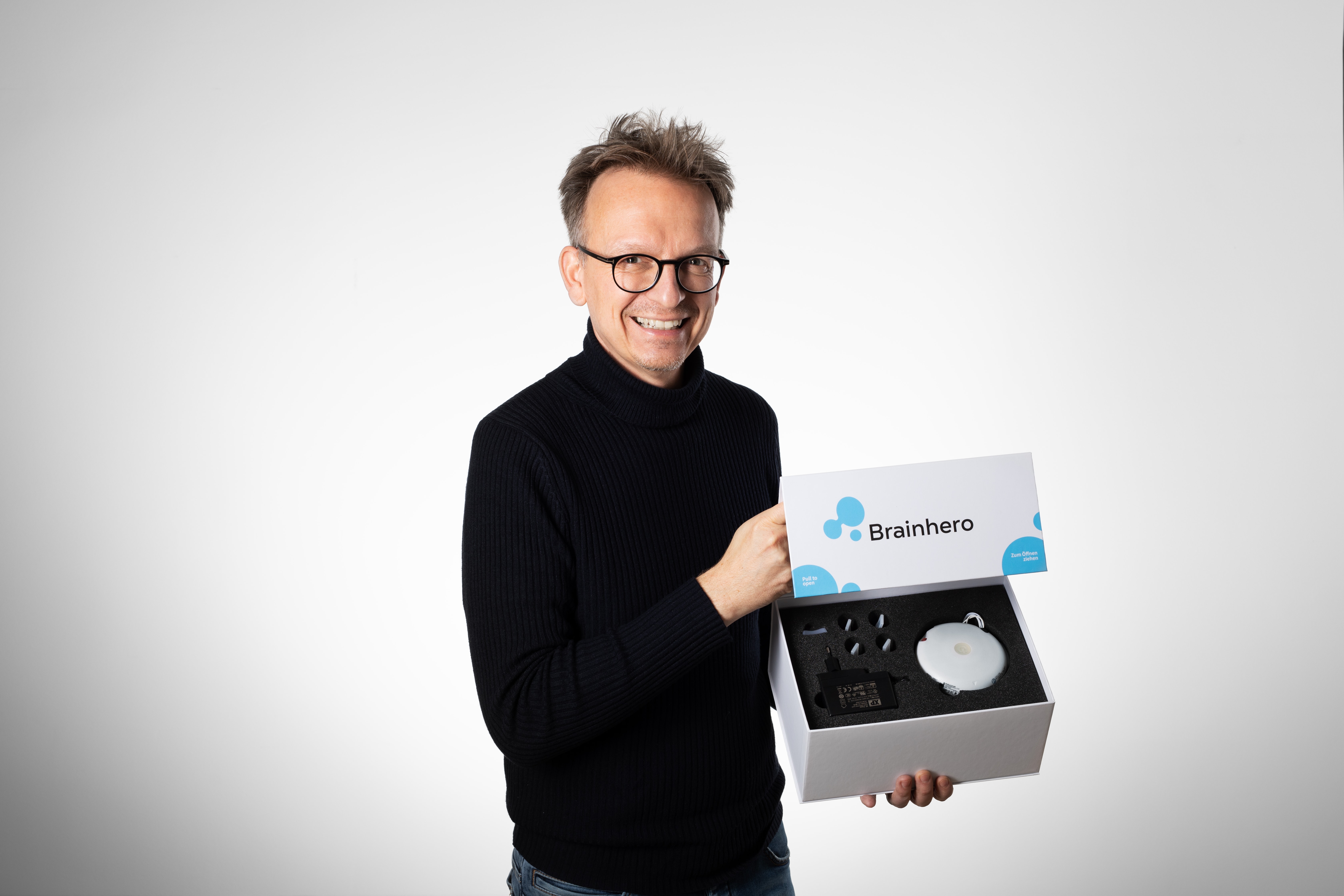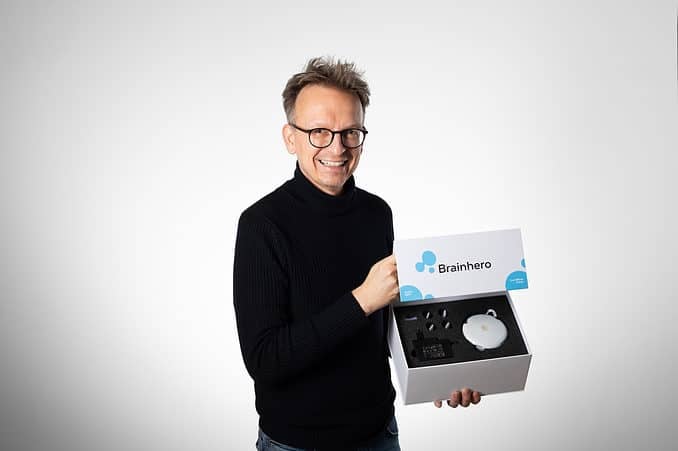
About Brainhero GmbH (Wien) Brainhero Neuro Lab GmbH (Innsbruck)
- Founders: Christof Götz, David Pollreisz
- Founded in: 2018
- Employees: 19 (internal), 5 (external)
- Money raised: Funding from Wirtschaftsagentur Austria, Austria Wirtschaft Service (AWS), Österreichische Forschungsförderungsgesellschaft (FFG); investments from IST Cube, ARAX and several funds.
- Ultimate goal: Initially, we will focus on autism therapy. In the long term, we would like to position ourselves as a mental health company
Christof Götz and Christine Hartlieb-Götz have a daughter who is affected by autism. In the course of her treatment, they came across neurofeedback therapy, a kind of strength training for the brain that tries to influence brain activity in a targeted way. In the process, they found that research focuses only on mild cases of autism, but the patient population has a high proportion of more severe cases.
For example, about 40 percent of those affected are nonverbal, 31 percent suffer from intellectual impairment and 25 percent have borderline personality syndrome. The results of the training were promising, however, and the idea for the start-up Brainhero took shape.
The couple found support in biomedical engineer David Pollreisz, a student at the Vienna University of Technology at the time, and now Brainhero’s CTO. In this episode of our Start-up of the Day series, co-founder Christof Götz talks about innovation and the challenges of starting up a company.
What problem are you solving and why is that important?
“We are about everyday life in families with children affected by autism. We create quality of life and enable therapists who are involved to do their job better. With our neurofeedback therapy, we want the child to be able to absorb more as they grow up and later, when they are an adult, have a better chance of living independently. In doing so, we provide the hardware and software—as well as the therapy itself— so we also have our own patient care team.”
How can neurofeedback therapy improve children’s lives?
“A person suffering from autism spectrum disorders (ASD) has difficulty establishing normal social relationships. So therapy tries to stimulate the development of social skills. The therapy is based on electroencephalography (EEG) in the form of a hood. Sometimes this therapy is only available in clinics at a high cost. We have developed a mobile EEG and a computer game for training at home. Brainhero is a protagonist that patients can control via their brain activity on the computer screen.”

More than one in one hundred children are affected by the so-called autism spectrum disorder, one of the most common neurodevelopmental disorders.
“It’s not easy. It’s a kind of barbell for the brain that gets heavier as the child learns. Training changes brain activity, and those changes show up in behavior. Research has shown that children affected by autism have lower right brain activation than their neurotypical peers—and this correlates with the severity of symptoms.
With our product, we can specifically address this anomaly. With each training session, children learn to direct their brain activity to a level similar to that of the corresponding neurotypical population. Over time, the changes become apparent in their behavior as well.”
What was the biggest obstacle you had to overcome?
“There were two things: the path to certification as a medical product, combined with taking into account the strict requirements of the EU’s General Data Protection Regulation (GDPR) regarding patient data. In addition, we are striving for Brainhero to be paid for by health insurance, one of our next big challenges. As a result, there are other strict rules that we have to follow. For instance, this includes ISO 27001, and American companies are not allowed to be used for storing patient data. This means that the European data centers of companies like Amazon and Google are explicitly excluded. These are extremely big obstacles and standards that also limit us in our creative game development.”
What have been the best moments so far?
“We did a clinical feasibility study for a future product and included more severe cases of autism. The best part was seeing children who were previously nonverbal start to name things and speak up to three-word sentences. They were able to communicate verbally for the first time. Their parents were very thankful.”
Was it hard to get funding for neurofeedback therapy?
“Yes, it was very difficult. We couldn’t have done it without the Austrian funding landscape, for which we are very grateful. Funding was essential for the development of the product, to obtain medical certification and to make the product availabile on the market. But now we are largely externally funded. Our main investor is IST Cube, with whom we are very happy. In the last round of funding, we got a number of funding sources, including Fair Finance. The latter is an impact fund that will also sponsor some of our therapies for individuals who can’t afford it or who can’t get therapy placements. We also have a silent partnership with ARAX. When you make this change to external sponsors, a lot of things change and the management effort increases.
We have been generating revenue for a few weeks now. We are not yet able to offer so many treatments due to the disrupted supply chains. But right now, our first larger batch is being produced and we will be able to provide larger quantities beginning in March or April 2023.”
Where would you like to be with your company in five years?
“The next thing we want to do is to evolve into a mental health company for neurological problems. To this end, we will personalize therapy by tailoring it to the individual structure and activity balance of the brain. Behind this is the fact that other neurological problems almost always accompany autism. So we need to address those problems, too. A frequent overlap, for example, is attention deficit hyperactivity disorder (ADHD), which is why we already offer our therapy for children with ADHD.
The feasibility study has shown that this works very well, although it remains to be seen which topics we can include in the certification. But we’re already working with our clinical and scientific partners on the next topics.”
What makes your neurofeedback therapy better/different than existing things?
“While there are many research projects on neurofeedback therapy, most don’t make it to market because they are too complicated to use. You can do similar therapies in clinics and practices, but it is usually not feasible for affected patients because the environment is foreign, you can’t choose the time and place, and you have to wear something rather uncomfortable on your head while doing it. We bring the therapy home as a medical product: it is easy to handle, comfortable to wear and usable at any time. This means that the training can be done more often and is also more cost-effective. We are priced at about half the price of standard therapies. There are also consumer devices that are not certified as medical products, aimed more at adults, and ultimately do nothing more than relax the patient.”

